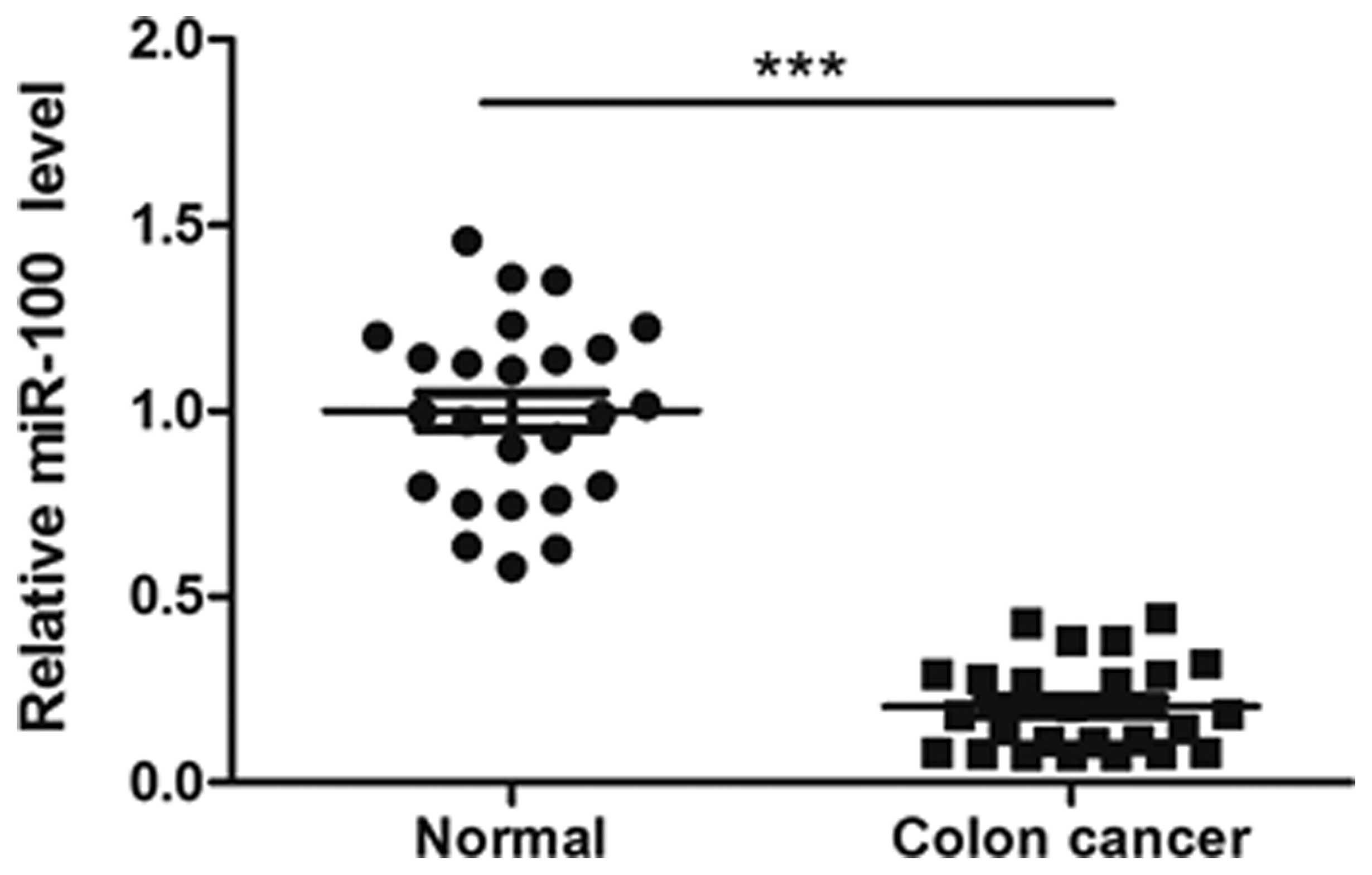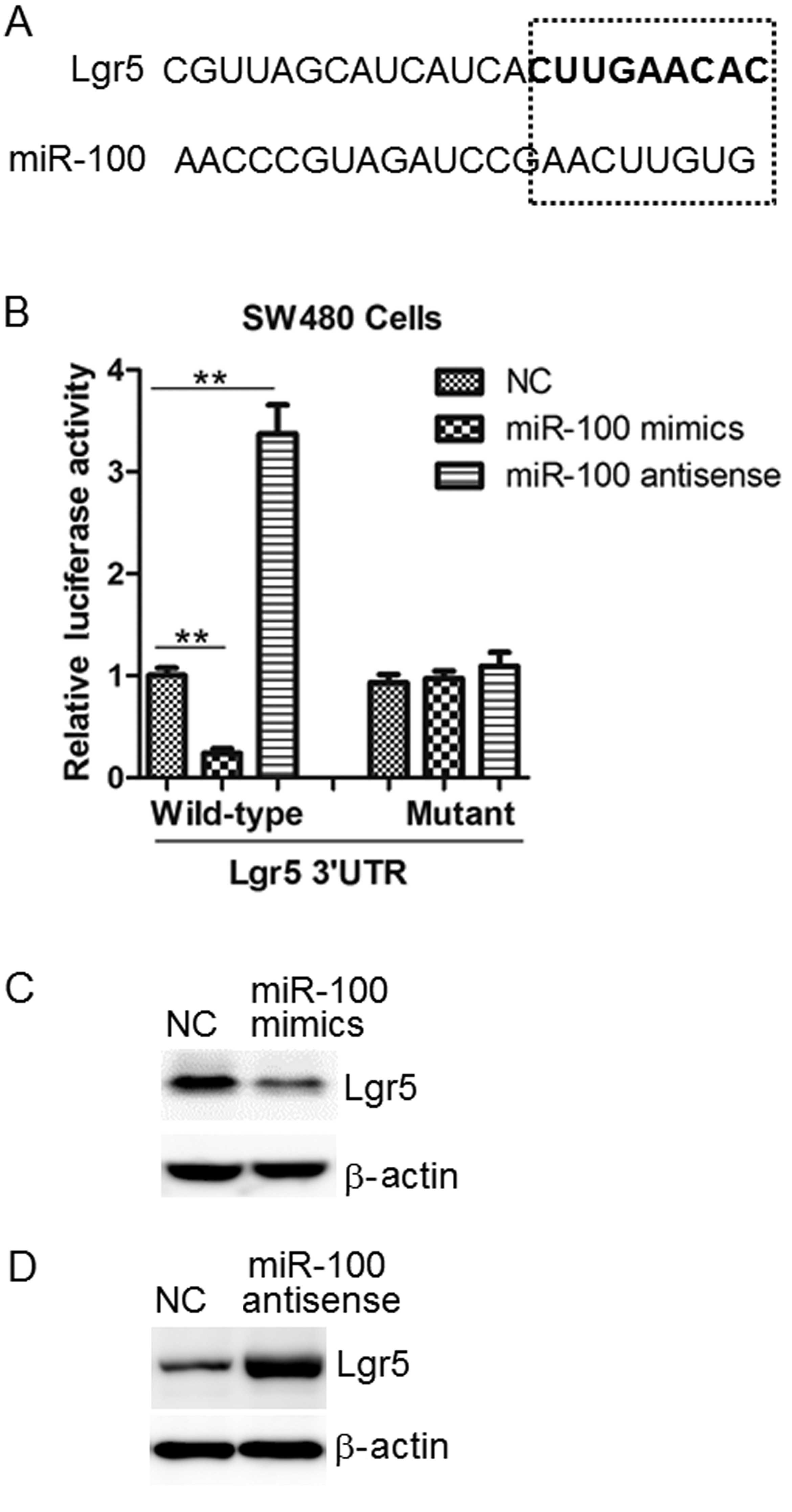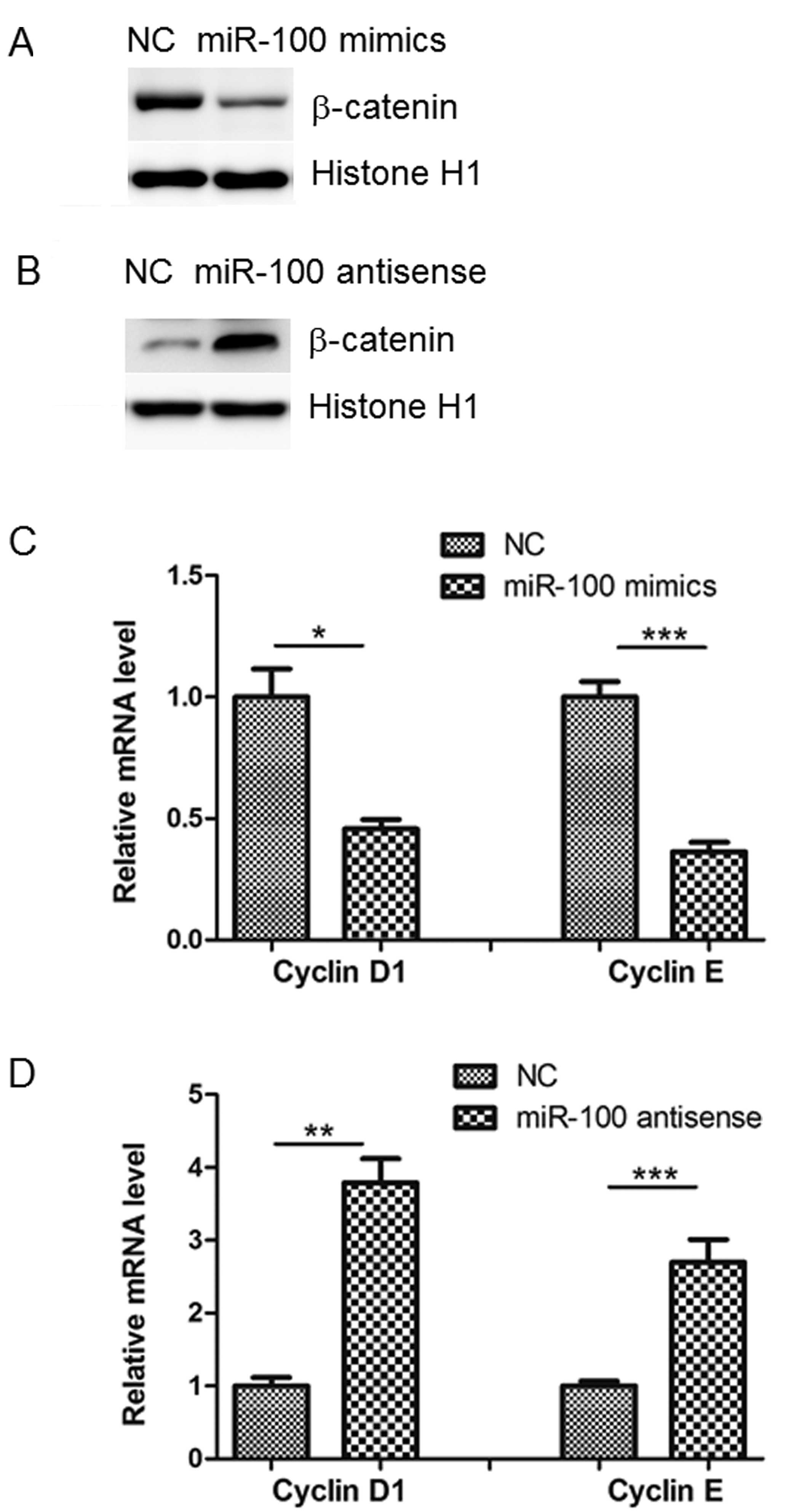MicroRNA-100 functions as a tumor suppressor by inhibiting Lgr5 expression in colon cancer cells
- Authors:
- Published online on: December 4, 2014 https://doi.org/10.3892/mmr.2014.3052
- Pages: 2947-2952
Abstract
Introduction
Colon cancer is the third most common type of cancer and the leading cause of cancer-associated mortality in Western communities (1,2). In China, the incidence is lower than in Western countries, but nevertheless is a substantial burden (3). The molecular mechanisms underlying the development of this type of cancer remain to be fully elucidated, thus there currently exist limited therapeutic options (4).
MicroRNAs (miRNAs) are a family of small non-coding RNA molecules of 18–27 nucleotides in length (5). In general, miRNAs negatively regulate gene expression by binding to the 3′-untranslated region (3′-UTR) of their target double-stranded mRNA, leading to degradation of the mRNA via the Dicer complex (6). The abnormal expression of certain miRNAs has been observed in various types of solid tumor, including colon cancer (7). For example, miRNA-21 has recently emerged as a novel biomarker in colon cancer, with the potential to be used as a diagnostic and therapeutic target (8). Additionally, several miRNAs have been reported to regulate colon cell growth, migration and invasion, including miR-32, -224 and -203 (9–11).
The current study investigated miR-100 using gain- and loss-of-function experiments, and the effect of up- or downregulation of miR-100 on the proliferation, migration and invasion of colon cells was determined.
Materials and methods
Human tissues
A total of 25 pairs of frozen primary colon cancer samples and corresponding histologically normal mucosa samples were obtained from the Department of Gastroeterology, Second Affiliated Hospital of Zhengzhou University (Zhengzhou, China). The diagnoses of these tissue samples were verified by pathologists. The current study was approved by the Ethics Committee of the Second Affiliated Hospital of Zhengzhou University.
Cell culture
The SW480 and HCT116 colon cancer cell lines were purchased from the cell bank of the Type Culture Collection of The Chinese Academy of Sciences (Shanghai, China), and cultured in Dulbecco’s modified Eagle’s medium (DMEM) supplemented with 10% fetal bovine serum, 100 IU/ml penicillin and 100 mg/ml streptomycin (all from Gibco Life Technologies, Carlsbad, CA, USA).
Cell transfection
miR-100 mimics, antisense oligonucleotides and negative controls (NCs) were purchased from Shanghai Genepharma Co., Ltd. (Shanghai, China). Transfections were performed using Lipofectamine 2000 (Invitrogen Life Technologies, Carlsbad, CA, USA), according to the manufacturer’s instructions.
RNA isolation and quantitative polymerase chain reaction (qPCR)
RNA was isolated from cells using TRIzol reagent (Invitrogen Life Technologies), and reverse transcription was performed with the Takara RNA PCR kit (Takara Biotechnology Co., Ltd., Dalian, China), according to the manufacturer’s instructions. In order to determine the transcripts of the genes of interest, qPCR was performed using a SYBR Premix Ex Taq master mix (Takara Biotechnology Co., Ltd.) with an ABI 7500 Real-Time PCR system (Applied Biosystems Life Technologies, Foster City, CA, USA). PCR cycling conditions included an initial holding period at 94°C for 5 min, followed by a two-step PCR program consisting of 40 cycles of 94°C for 5 sec and 60°C for 30 sec. Expression of U6 small nuclear RNA was determined as an internal control. Primer sequences were as follows: Cyclin D1, F 5′-GCTGCGAAGTGGAAACCATC-3′ and R 5′-CCTCCTTCTGCACACATTTGAA-3′; cyclin E, F 5′-AAGGAGCGGGACACCATGA-3′ and R 5′-ACGGTCACGTTTGCCTTCC-3′.
Bromodeoxyuridine (BrdU) incorporation assays
For the BrdU incorporation assays, a BrdU cell proliferation enzyme-linked immunosorbent assay kit (Beyotime Institute of Biotechnology, Shanghai, China) was used to analyze the incorporation of BrdU during the S phase of the cell cycle in the SW480 and HCT116 cells, in accordance with the manufacturer’s instructions. All experiments were repeated a minimum of three times in quadruplicate.
MTT assay
The cell viability was determined by assaying the reduction of 3-(4, 5-dimethylthiazol-2-yl)-2, 5-di-phenyltetrazolium bromide (MTT) to formazan. SW480 and HCT116 cells were cultured in DMEM at a concentration of 60–70%, prior to the addition of 100 μl MTT (Beyotime Institute of Biotechnology) for 4 h. The cell viability in the different samples was measured using a Raman spectrophotometer (B&W Tek, Inc., Newark, DE, USA) at a wavelength of 470 nm.
Cell migration and invasion assays
Subsequent to transfection of the SW480 and HCT116 cells with miR-100 mimics, antisense or NC for 24 h, cell migration and invasion were analyzed. The cells were seeded in Transwell migration or extracellular matrix-coated invasion chambers (Tumor Cell Transendothelial Migration Assay kit and ECMatrix Cell Invasion Assay kit, respectively; EMD Millipore, Temecula, CA, USA) and incubated for a further 24 h. Subsequently, the Transwell migration assay or invasion assay was conducted according to manufacturer’s instructions. Cell migration and invasion were quantified with an iMark Microplate Absorbance Reader (#168–1130; Bio-Rad Laboratories, Hercules, CA, USA) at 570 nm, according to the manufacturer’s instructions.
Luciferase reporter assay
Total cDNA from SW480 cells was obtained from mRNA using a Reverse Transcription System (Promega Corporation, Madison, WI, USA) according to the manufacturer’s protocols. The cDNA was used to amplify the 3′-UTR of Lgr5 by PCR. The Lgr5 3′UTR was cloned into pMir-Report (Ambion Life Technologies, Shanghai, China), yielding pMir-Report-Lgr5. Mutations were introduced in potential miR-100 binding sites using the QuikChange site-directed mutagenesis kit (Agilent Technologies, Shanghai, China). Cells were transfected with the pMir-Report vectors containing the 3′-UTR variants with miR-100 mimics or antisense for 36 h. The pRL-TK vector (Promega Corporation) carrying the Renilla luciferase gene was used as an internal control to normalize the transfection efficiency. Luciferase values were determined using the Dual-Luciferase Reporter Assay System (Promega Corporation). miRWalk software (www.umm.uni-heidelberg.de/apps/zmf/mirwalk/) was used for analysis.
Western blot
Following transfection of mimics, antisense or NC, tissues or SW480 cells were lysed with RIPA buffer (Beyotime Institute of Biotechnology). The protein (40 μg) was subjected to 7.5% SDS-PAGE (Shanghai Sangong Pharmaceutical Co., Ltd., Shanghai, China) on a PowerPAC HC High-Current Power Supply electrophoresis machine (Bio-Rad Laboratories), and separated proteins were transferred to nitrocellulose membranes (EMD Millipore). The membranes were incubated overnight at 4°C with the following antibodies: Monoclonal mouse anti-human β-actin (1:1,000; sc-130065); polyclonal rabbit anti-human leucine-rich-repeat-containing G protein-coupled receptor 5 (Lgr5; 1:2,000; sc-135238); monoclonal rabbit anti-human β-catenin (1:2,000; sc-376841); and polyclonal goat anti-human histone H1 (1:1,000; sc-247158) (all Santa Cruz Biotechnology, Inc., Dallas, TX, USA). The immunoreactive bands were detected with a ChemiGlow West Chemiluminescence Substrate kit (ProteinSimple, Santa Clara, CA, USA) with the FluorChem FC2 system (NtureGene Corporation, Beijing, China).
Statistical analysis
Data are presented as the mean ± standard error. Statistical analysis was performed with SPSS, version 13.0 (SPSS, Inc., Chicago, IL, USA). P<0.05 was considered to indicate a statistically significant difference.
Results
miR-100 is downregulated in colon cancer tissues
The expression level of miR-100 in 25 pairs of human tissues was measured by RT-qPCR. As demonstrated in Fig. 1, the miR-100 expression level was significantly lower in colon cancer tissues compared with the level in matched adjacent normal tissues (P<0.001).
miR-100 reduces the viability, proliferation, migration and invasion of colon cancer cells
To investigate the function of miR-100 in tumorigenesis, gain- and loss-of-function experiments involving the introduction of mimics or antisense oligonucleotides into SW480 and HCT116 cells were performed. Scramble sequences were used for the NC group. As observed with the MTT and BrdU incorporation assays, cell viability and proliferation levels were significantly reduced in SW480 cells in which miR-100 was overexpressed, but enhanced by miR-100 antisense (Fig. 2A and B). Additionally, miR-100 mimics significantly inhibited the in vitro migration and invasion abilities of SW480 cells, whereas its antisense enhanced these processes (Fig. 2C and D). Similar results were also observed in the HCT116 cells (Fig. 3).
Lgr5 is a target of miR-100 in colon cancer cells
Bioinformatics software (miRWalk) was used to screen for the target gene of miR-100 in colon cancer cells. The results indicated Lgr5 to be a target of miR-100 (Fig. 4A). The luciferase activity assay established that miR-100 mimics significantly suppressed the activity of the wild-type 3′-UTR, while its antisense upregulated it. However, this effect was not observed in the mutant in SW480 cells (Fig. 4B).
Protein levels of Lgr5 and β-catenin are altered by miR-100
Consistent with the bioinformatic analysis and luciferase assay results, western blot analysis indicated that miR-100 mimics reduced Lgr5 protein levels compared with NC levels in SW480 cells, whilst miR-100 antisense produced the opposite effect (Fig. 4C and D). A previous study demonstrated that Lgr5 promotes tumor growth and progression through the activation of Wnt/β-catenin signaling (12). In agreement with this, it was observed in the current study that miR-100 mimics inhibited, while its antisense promoted, nuclear β-catenin accumulation in SW480 cells (Fig. 5A and B). The results of the present study were in accordance with a previous study that demonstrated that cyclin D1 and E were reduced or increased by transfection of miR-100 mimics or antisense, respectively (13). This indicates that downstream targets of β-catenin are also influenced by miR-100 (Fig. 5C and D).
Discussion
Identification of cancer-specific miRNAs may be important for understanding the role they perform in tumorigenesis and exploring novel therapeutic targets. Previous studies have demonstrated that miR-100 is downregulated in several types of malignancy, including osteosarcoma, acute myeloid leukemia, and lung and hepatocellular carcinoma (14–17). miR-100 has been identified as a potential molecular marker of non-small cell lung cancer, and functions as a tumor suppressor by targeting polo-like kinase 1 (17). miR-100 has also been demonstrated to inhibit breast cancer proliferation and survival through the suppression of insulin-like growth factor 2 and β-tubulin (18). This indicates a fundamental function for miRNA as a tumor suppressor. However, the function of miR-100 in colon cancer biology remains unclear.
In the current study, the expression and potential functions of miR-100 in the regulation of the biological properties of colon cancer cells were investigated. miR-100 expression was demonstrated to be downregulated in colon cancer tissues compared with adjacent normal tissues. The subsequent gain- and loss-of-function studies suggested that miR-100 was able to reduce colon cancer cell viability, proliferation, migration and invasion in vitro.
To further explore the molecular mechanisms involved in miR-100-mediated effects on biological properties, Lgr5 was selected for further study as it was predicted to be a target of miR-100 by bioinformatics analysis. Lgr5, also known as G protein-coupled receptor 49, is a regulator of Wnt signaling (19). Consistent with the dysregulation of Wnt/β-catenin signaling, Lgr5 is overexpressed in hepatocellular carcinoma, colon and ovarian cancer, basal cell carcinoma and esophageal adenocarcinoma (20–22). This suggests an important function for Lgr5 in tumorigenesis. Adenomatous polyposis coli mutations observed exclusively in Lgr5-positive cells have been identified to be able to promote adenomatous growth in the colon of mice (23). In addition to patients, the overexpression of Lgr5 has been demonstrated to correlate with poor survival of colon cancer in mice (24). However, the precise molecular mechanisms underlying the upregulation of Lgr5 in colon cancer remain to be fully elucidated, and thorough investigation is required.
Additionally, nuclear localization of β-catenin and expression of its down-stream target genes, including cyclin D1 and cyclin E were demonstrated to be regulated by miR-100. Thus, the downregulation of miR-100 may be an important mechanism for the aberrant activation of Wnt signaling in human cancer.
To the best of our knowledge, the results from the current study, for the first time explore the function of miR-100 in the progression of colon cancer. Future studies, including the generation of miR-100 knockout mice, are required to establish the physiological function of miR-100 in tumorigenesis.
References
|
Des Guetz G, Uzzan B, Bouillet T, et al: Impact of physical activity on cancer-specific and overall survival of patients with colorectal cancer. Gastroenterol Res Pract. 2013:3408512013. View Article : Google Scholar : PubMed/NCBI | |
|
Søgaard M, Thomsen RW, Bossen KS, Sørensen HT and Nørgaard M: The impact of comorbidity on cancer survival: a review. Clin Epidemiol. 5(Suppl 1): 3–29. 2013. View Article : Google Scholar : PubMed/NCBI | |
|
Chiu BC, Ji BT, Dai Q, Gridley G, McLaughlin JK, Gao YT, Fraumeni JF Jr and Chow WH: Dietary factors and risk of colon cancer in Shanghai, China. Cancer Epidemiol Biomarkers Prev. 12:201–208. 2003.PubMed/NCBI | |
|
Walker AS, Zwintscher NP, Johnson EK, Maykel JA, Stojadinovic A, Nissan A, Avital I, Brücher BL and Steele SR: Future directions for monitoring treatment response in colorectal cancer. J Cancer. 5:44–57. 2014. View Article : Google Scholar : PubMed/NCBI | |
|
Sun K and Lai EC: Adult-specific functions of animal microRNAs. Nat Rev Genet. 14:535–548. 2013. View Article : Google Scholar : PubMed/NCBI | |
|
Ameres SL and Zamore PD: Diversifying microRNA sequence and function. Nat Rev Mol Cell Biol. 14:475–488. 2013. View Article : Google Scholar : PubMed/NCBI | |
|
Wu WK, Law PT, Lee CW, Cho CH, Fan D, Wu K, Yu J and Sung JJ: MicroRNA in colorectal cancer: from benchtop to bedside. Carcinogenesis. 32:247–253. 2011. View Article : Google Scholar | |
|
Kjaer-Frifeldt S, Hansen TF, Nielsen BS, Joergensen S, Lindebjerg J, Soerensen FB, dePont Christensen R and Jakobsen A: The prognostic importance of miR-21 in stage II colon cancer: a population-based study. Br J Cancer. 107:1169–1174. 2012. View Article : Google Scholar : PubMed/NCBI | |
|
Wu W, Yang J, Feng X, Wang H, Ye S, Yang P, Tan W, Wei G and Zhou Y: MicroRNA-32 (miR-32) regulates phosphatase and tensin homologue (PTEN) expression and promotes growth, migration, and invasion in colorectal carcinoma cells. Mol Cancer. 12:302013. View Article : Google Scholar : PubMed/NCBI | |
|
Yuan K, Xie K, Fox J, Zeng H, Gao H, Huang C and Wu M: Decreased levels of miR-224 and the passenger strand of miR-221 increase MBD2, suppressing maspin and promoting colorectal tumor growth and metastasis in mice. Gastroenterology. 145:853–864. 2013. View Article : Google Scholar : PubMed/NCBI | |
|
Schetter AJ, Leung SY, Sohn JJ, Zanetti KA, et al: MicroRNA expression profiles associated with prognosis and therapeutic outcome in colon adenocarcinoma. JAMA. 299:425–436. 2008. View Article : Google Scholar : PubMed/NCBI | |
|
Haegebarth A and Clevers H: Wnt signaling, lgr5, and stem cells in the intestine and skin. Am J Pathol. 174:715–721. 2009. View Article : Google Scholar : PubMed/NCBI | |
|
Wilson C: Diabetes: Human β-cell proliferation by promoting Wnt signalling. Nat Rev Endocrinol. 9:5022013. View Article : Google Scholar | |
|
Huang J, Gao K, Lin J and Wang Q: MicroRNA-100 inhibits osteosarcoma cell proliferation by targeting Cyr61. Tumour Biol. 35:1095–1100. 2014. View Article : Google Scholar | |
|
Zheng YS, Zhang H, Zhang XJ, Feng DD, et al: MiR-100 regulates cell differentiation and survival by targeting RBSP3, a phosphatase-like tumor suppressor in acute myeloid leukemia. Oncogene. 31:80–92. 2012. View Article : Google Scholar : | |
|
Chen P, Zhao X and Ma L: Downregulation of microRNA-100 correlates with tumor progression and poor prognosis in hepatocellular carcinoma. Mol Cell Biochem. 383:49–58. 2013. View Article : Google Scholar : PubMed/NCBI | |
|
Liu J, Lu KH, Liu ZL, Sun M, De W and Wang ZX: MicroRNA-100 is a potential molecular marker of non-small cell lung cancer and functions as a tumor suppressor by targeting polo-like kinase 1. BMC Cancer. 12:5192012. View Article : Google Scholar : PubMed/NCBI | |
|
Gebeshuber CA and Martinez J: miR-100 suppresses IGF2 and inhibits breast tumorigenesis by interfering with proliferation and survival signaling. Oncogene. 32:3306–3310. 2013. View Article : Google Scholar | |
|
Leushacke M and Barker N: Lgr5 and Lgr6 as markers to study adult stem cell roles in self-renewal and cancer. Oncogene. 31:3009–3022. 2012. View Article : Google Scholar | |
|
Fukuma M, Tanese K, Effendi K, Yamazaki K, Masugi Y, Suda M and Sakamoto M: Leucine-rich repeat-containing G protein-coupled receptor 5 regulates epithelial cell phenotype and survival of hepatocellular carcinoma cells. Exp Cell Res. 319:113–121. 2013. View Article : Google Scholar | |
|
Zeki SS, Graham TA and Wright NA: Stem cells and their implications for colorectal cancer. Nat Rev Gastroenterol Hepatol. 8:90–100. 2011. View Article : Google Scholar : PubMed/NCBI | |
|
Schuijers J and Clevers H: Adult mammalian stem cells: the role of Wnt, Lgr5 and R-spondins. EMBO J. 31:2685–2696. 2012. View Article : Google Scholar : PubMed/NCBI | |
|
Lewis A, Segditsas S, Deheragoda M, et al: Severe polyposis in Apc(1322T) mice is associated with submaximal Wnt signalling and increased expression of the stem cell marker Lgr5. Gut. 59:1680–1686. 2010. View Article : Google Scholar : PubMed/NCBI | |
|
Liu Z, Dai W, Jiang L and Cheng Y: Over-expression of LGR5 correlates with poor survival of colon cancer in mice as well as in patients. Neoplasma. 61:177–185. 2014. View Article : Google Scholar |














